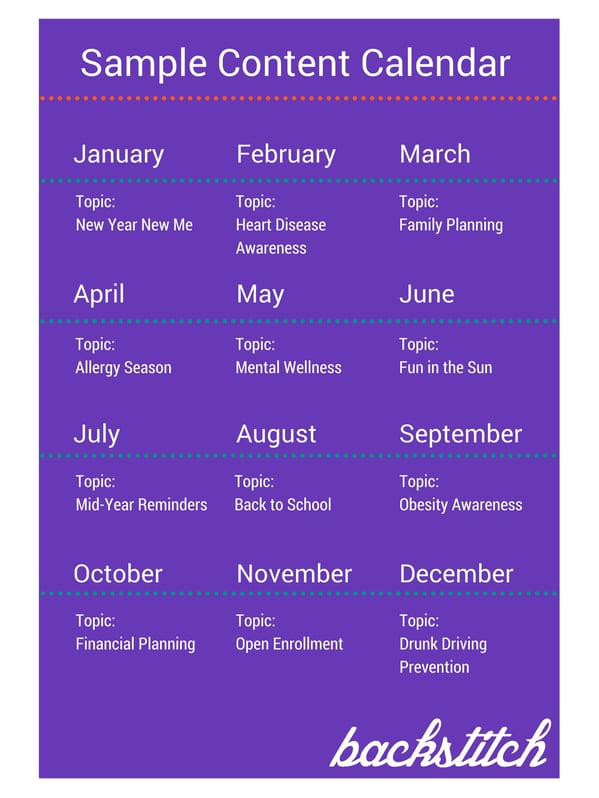Adored and touted by journalists and marketers alike, a content calendar is an essential tool for any communicator.
A content calendar is a way to plan and organize upcoming content and messages. This can include blog posts, videos and other assets. Although this might seem like a straightforward idea, this can easily become an afterthought for internal communicators as they balance content planning with all of their other responsibilities.
Intentionally scheduling your content can make a big difference in how your message is received. For this reason, a calendar can be also a useful tool that benefits professionals can borrow to upgrade their communication and increase proper utilization of benefits.
Only 19 percent of employers report that their employees have a “high level” of understanding of their employee benefits, according to a recent report.
In addition, approximately 50 percent of employees don’t fully understand the information in employee benefit materials — with more than 80 percent of employees not even reading benefits collateral in its entirety.
We get it — benefits professionals are often very busy and have a lot on their plate. They don’t always have as much time to devote campaigns as their colleagues in marketing or corporate communications do.
However, implementing manageable tools — like a content calendar — can not only create a positive impact on each individual employee, it can actually reduce the time and effort spent on campaigns in the long term.
Here are the steps you need to take to create your very own calendar. (Plus a free downloadable template!)
Step No. 1: Identify your audience

Depending on your organization, there will a different audience — or audiences — that your messaging will need to target. The most effective communication will require segmenting in some form or fashion.
Whether that be segmenting your employee population by management level, department or union vs. nonunion. Or, perhaps employees who are enrolled in benefits vs. employees who are not enrolled. Other examples include benefits plan participation, tenure, role, location or individual aspiration.
Make a list of the different segments of your organization your content is targeting specifically. Then, use this list to brainstorm which specific type of content and medium will work best for each of these groups.
Step No. 2: Decide which communication medium you’d like to use

There are many ways to communicate, and the written word is just one of those ways. Decide within your organization what communication method works for best your team.
Will you prioritize articles? Email newsletters? Video? Graphic images? Case studies? Company wide wellness challenges?
There are plenty of ways to get your message across. Make a list of what kind of content you’d like to create for your benefits communications.
Example mediums: Article, Video, Audio Podcast, Photos, Infographic, Survey, Company-Wide Challenge
Step No. 3: Select which communication channels you’d like to share your content through

Now that you’ve concluded what types of content your organization is interested in creating, where would you like that content to be shared? And once the content is shared, where would you like it to live?
There are many ways to send a message. At backstitch, we recommend using a combination of multiple channels. That way, you know that your employees will have multiple chances to engage with your message.
Example channels: Company Intranet, Email Newsletter, Website, Employee App, Push Notification, SMS Text Message
Step No. 4: Brainstorm potential content

Now, it’s time to brainstorm.
We recommend taking your list of audiences and comparing that to your list of communication types. Now, brainstorm content ideas that would work for each category.
For example, let’s say one of your audience segment is all of your employees who aren’t yet signed up for benefits and one of your chosen communication tool is an article. Combine both of these and create as many article ideas that would be relevant to this population.
Repeat this process until you’ve covered each combination and feel good about the amount of ground you’ve covered.
Step No. 5: Plan your process

Now that you know what you’re creating and who you’re creating it for, ask yourself — how often should I communicate my messages?
Decide the optimum frequency of communication, when is a good time to push messages to employees and your “content mix.”
By content mix, we mean the ratio of what type of content you’ll be producing. Should it be 80 percent written, with 20 percent visual? How often do you want to launch an employee challenge, and what percentage of your messages should be challenges?
How will your communication be shared? We recommend a dynamic strategy where messages are shared in a variety of ways. Try and utilize email newsletters, push notifications, images
Click here to see how backstitch can help your benefits team schedule one message via multiple communication platforms.
Something else you might want to keep in mind is timely events that might be relevant to your content strategy. Nowadays, there is a “National Day” for just about every occurrence. If your benefits team is creating messages about health and wellness, perhaps it might be useful to piggyback off of one of those ideas.
Here is an example of a high-level, content calendar for benefits professionals that can guide your specific content strategy:

Step No. 6: Create a master spreadsheet
Once you’ve got that down, it’s time to start planning your content.
We recommend using an a spreadsheet tool — such as Microsoft Excel or Google Sheets — and create a master list of all of your planned content. Organize it by title, publish date, audience and communication medium.
Although it still might seem a little daunting to put together an organized internal content calendar, don’t panic. Just stick with it one day at a time. The more you utilize a calendar, the better and more consistent your communication strategy will be in the long run.



